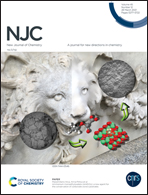Effect of the electronic structure on the robustness of ruthenium(ii) bis-phenanthroline compounds for photodissociation of the co-ligand: synthesis, structural characterization, and density functional theory study†
Abstract
Distorted octahedral ruthenium(II) bis-phenanthroline compounds of the type cis-[Ru(phen)2(L)2](PF6)2 (L = isoquinoline 1; phthalazine 2) were synthesized and their photochemistry was investigated. The photodissociation of the monodentate N-heterocyclic co-ligands upon blue light irradiation (λirr = 470 nm) occurs much more readily in 1 than in 2 with the first ligand dissociating faster than the second ligand. The density functional theory (DFT) calculations were performed to investigate geometries of the 3MLCT, 3TS, and dissociative 3MC states and the triplet potential energy surfaces. DFT and time-dependent DFT (TD-DFT) calculations reveal a smaller 3MLCT-3MC energy gap for 1 (0.025 eV) than in 2 (0.090 eV) suggesting the faster dissociation of the first co-ligand in both 1 and 2. On the other hand, the 3MLCT-3MC energy gap is moderately larger for the monochloro-substituted photoproducts 1a (0.389 eV) and 2a (0.396 eV), leading to the conclusion that the second co-ligand dissociation is slower in both 1a and 2a. This is also in agreement with the observed values of quantum yields. Molecular orbital analysis along the triplet potential energy surface scan for Ru–N(co-ligand) bond stretching suggests that the lower energy singly occupied molecular orbital (SOMO1) of 3MLCT, comprised of a dπ orbital of Ru with little contribution of π orbital of the co-ligand, does not change much when Ru–N bond stretches to reach 3MC. The higher-energy SOMO2 of the 3MLCT state is mostly phenanthroline based π* orbital. Upon stretching the Ru–N distance, the π* orbital of phenanthroline in the 3MLCT state and dσ* orbital of the dissociative 3MC state are seen to be mixing in an antibonding fashion especially after transition state (3TS). This mixing of the dσ* orbital with the π* orbital is one of the important factors favoring the release of the N-heterocyclic co-ligand to give photodissociation products.



 Please wait while we load your content...
Please wait while we load your content...